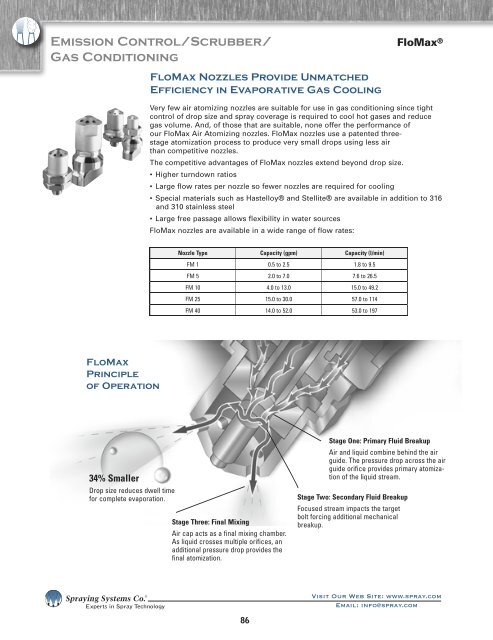Spray Nozzles Spray Control Spray Analysis Spray Fabrication
Spray Nozzles Spray Control Spray Analysis Spray Fabrication
Spray Nozzles Spray Control Spray Analysis Spray Fabrication
Create successful ePaper yourself
Turn your PDF publications into a flip-book with our unique Google optimized e-Paper software.
Emission <strong>Control</strong>/Scrubber/<br />
Gas Conditioning<br />
FloMax ®<br />
FloMax <strong>Nozzles</strong> Provide Unmatched<br />
Efficiency in Evaporative Gas Cooling<br />
Very few air atomizing nozzles are suitable for use in gas conditioning since tight<br />
control of drop size and spray coverage is required to cool hot gases and reduce<br />
gas volume. And, of those that are suitable, none offer the performance of<br />
our FloMax Air Atomizing nozzles. FloMax nozzles use a patented threestage<br />
atomization process to produce very small drops using less air<br />
than competitive nozzles.<br />
The competitive advantages of FloMax nozzles extend beyond drop size.<br />
• Higher turndown ratios<br />
• Large flow rates per nozzle so fewer nozzles are required for cooling<br />
• Special materials such as Hastelloy® and Stellite® are available in addition to 316<br />
and 310 stainless steel<br />
• Large free passage allows flexibility in water sources<br />
FloMax nozzles are available in a wide range of flow rates:<br />
Nozzle Type Capacity (gpm) Capacity (l/min)<br />
FM 1 0.5 to 2.5 1.8 to 9.5<br />
FM 5 2.0 to 7.0 7.6 to 26.5<br />
FM 10 4.0 to 13.0 15.0 to 49.2<br />
FM 25 15.0 to 30.0 57.0 to 114<br />
FM 40 14.0 to 52.0 53.0 to 197<br />
FloMax<br />
Principle<br />
of Operation<br />
34% Smaller<br />
Drop size reduces dwell time<br />
for complete evaporation.<br />
Stage Three: Final Mixing<br />
Air cap acts as a final mixing chamber.<br />
As liquid crosses multiple orifices, an<br />
additional pressure drop provides the<br />
final atomization.<br />
Stage One: Primary Fluid Breakup<br />
Air and liquid combine behind the air<br />
guide. The pressure drop across the air<br />
guide orifice provides primary atomization<br />
of the liquid stream.<br />
Stage Two: Secondary Fluid Breakup<br />
Focused stream impacts the target<br />
bolt forcing additional mechanical<br />
breakup.<br />
<br />
<br />
86

















